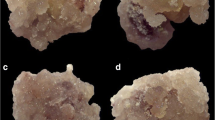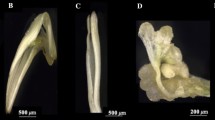Abstract
Sinopodophyllum hexandrum (Royle) T. S. Ying, an important source of podophyllotoxin (PTOX), has become a rare and endangered plant because of over-harvesting. Somatic embryogenesis (SE) is the main way of seedling rapid propagation and germplasm enhancement, but the regeneration of S. hexandrum has not been well established, and the PTOX biosynthesis abilities at different SE stages remain unclear. Therefore, it is extremely important to elucidate the SE mechanism of S. hexandrum and clarify the biosynthesis variation of PTOX. In this study, the transcriptomes of S. hexandrum at different SE stages were sequenced, the contents of PTOX and 4'-demethylepipodophyllotoxin were assayed, and the transcript expression patterns were validated by qRT-PCR. The results revealed that plant hormone (such as auxins, abscisic acid, zeatin, and gibberellins) related pathways were significantly enriched among different SE stages, indicating these plant hormones play important roles in SE of S. hexandrum; the expression levels of a series of PTOX biosynthesis related genes as well as PTOX and 4'-demethylepipodophyllotoxin contents were much higher in embryogenic callus stage than in the other stages, suggesting embryogenic callus stage has the best PTOX biosynthesis ability among different SE stages. This study will contribute to germplasm conservation and fast propagation of S. hexandrum, and facilitate the production of PTOX.






Similar content being viewed by others

Data availability
The RNA-seq raw data have been deposited in NCBI database with the accessions numbers of SAMN29987050, SAMN29987051, SAMN29987052, and SAMN29987053. The other data presented in this study are available on request from the corresponding author.
References
Acanda Y, Martínez Ó, Prado MJ, González MV, Rey M (2020) Changes in abscisic acid metabolism in relation to the maturation of grapevine (Vitis vinifera L. cv. Mencia) somatic embryos. BMC Plant Biol 20(1):487
Bhattacharyya D, Sinha R, Hazra S, Datta R, Chattopadhyay S (2013) De novo transcriptome analysis using 454 pyrosequencing of the Himalayan Mayapple Podophyllum hexandrum. BMC Genomics 14:748
Cueno ME, Imai K, Ochiai K, Okamoto T (2012) Cytokinin dehydrogenase differentially regulates cytokinin and indirectly affects hydrogen peroxide accumulation in tomato leaf. J Plant Physiol 169(8):834–838
Fan H, Zhu Z, Xian H, Wang H, Chen B, Tang Y, Tang Y, Liang X (2021) Insight into the molecular mechanism of podophyllotoxin derivatives as anticancer drugs. Front Cell Dev Biol 9:709075
Fu L (1992) Plant red book of China: rare threatened plant. Science Press, Beijing
Giri A, Lakshmi NM (2000) Production of podophyllotoxin from Podophyllum hexandrum: a potential natural product for clinically useful anticancer drugs. Cytotechnology 34:17–26
Guo S, Chen Y, Zhu Y (2022) Changes of endogenous hormones during somatic embryogenesis of Sinopodophyllum emodi. Fenzi Zhiwu Yuzhong (Molecular Plant Breeding) 20(24):8264–8271
Guo S, Zhu Y, Guan Y (2015a) The research progress of endangered Chinese medicinal herb of Sinopodophyllum Hexandrum (Royle) Ying. Ningxia J Agric For Sci Technol 56(11):77–79
Guo S, Zhu Y, Guan Y (2015) Callus induction of different explants of Sinopodophyllum emodi (Wall.) Ying. Chin Agric Sci Bull 31(36):150–155
Kharkwal AC, Kushwaha R, Prakash O, Ogra RK, Bhattacharya A, Nagar PK, Ahuja PS (2008) An efficient method of propagation of Podophyllum hexandrum: an endangered medicinal plant of the Western Himalayas under ex situ conditions. J Nat Med 62(2):211–216
Kim YS, Lim S, Choi YE, Anbazhagan VR (2007) High frequency plant regeneration via somatic embryogenesis in Podophyllum peltatum L. an important medicinal plant for source of anticancer drug. Curr Sci 92:662–666
Kumar P, Padhan J, Kumar A, Chauhan R (2017a) Transcriptomes of Podophyllum hexandrum unravel candidate miRNAs and their association with the biosynthesis of secondary metabolites. J Plant Biochem Biotechnol 27:46–54
Kumar P, Jaiswal V, Pal T, Singh J, Chauhan RS (2017) Comparative whole-transcriptome analysis in Podophyllum species identifies key transcription factors contributing to biosynthesis of podophyllotoxin in P. hexandrum. Protoplasma 254(1):217–228
Kumari A, Singh D, Kumar S (2017) Biotechnological interventions for harnessing podophyllotoxin from plant and fungal species: current status challenges and opportunities for its commercialization. Crit Rev Biotechnol 37(6):739–753
Kumari A, Singh HR, Jha A, Swarnkar MK, Shankar R, Kumar S (2014) Transcriptome sequencing of rhizome tissue of Sinopodophyllum hexandrum at two temperatures. BMC Genomics 15:871
Kushiro T, Okamoto M, Nakabayashi K, Yamagishi K, Kitamura S, Asami T, Hirai N, Koshiba T, Kamiya Y, Nambara E (2004) The Arabidopsis cytochrome P450 CYP707A encodes ABA 8′-hydroxylases: key enzymes in ABA catabolism. EMBO J 23(7):1647–1656
Lalaleo L, Testillano P, Risueño MC, Cusidó RM, Palazon J, Alcazar R, Bonfill M (2018) Effect of in vitro morphogenesis on the production of podophyllotoxin derivatives in callus cultures of Linum album. J Plant Physiol 228:47–58
Mashiguchi K, Tanaka K, Sakai T, Sugawara S, Kawaide H, Natsume M, Hanada A, Yaeno T, Shirasu K, Yao H, McSteen P, Zhao Y, Hayashi K, Kamiya Y, Kasahara H (2011) The main auxin biosynthesis pathway in Arabidopsis. Proc Natl Acad Sci USA 108:18512–18517
Meng Z, Yao T, Zhao W, Li H, Tang Y (2021) Research progress in biosynthesis of podophyllotoxin and its derivatives. Sheng wu gong cheng xue bao = Chin J Biotechnol 37(6):2026–2038
Montero-Córtes M, Sáenz L, Córdova I, Quiroz A, Verdeil JL, Oropeza C (2010) GA3 stimulates the formation and germination of somatic embryos and the expression of a KNOTTED-like homeobox gene of Cocos nucifera (L.). Plant Cell Rep 29(9):1049–59
Nic-Can, GI, Loyola-Vargas, VM (2016). The role of the auxins during somatic embryogenesis. In: Loyola-Vargas, V, Ochoa-Alejo, N (eds) Somatic Embryogenesis: Fundamental Aspects and Applications. Springer, Cham, pp 171–182
Peter H (2020) The current status of research on gibberellin biosynthesis. Plant Cell Physiol 61:1832–1849
Rajesh M, Sivanandhan G, Jeyaraj M, Chackravarthy R, Manickavasagam M, Selvaraj N, Ganapathi A (2014a) An efficient in vitro system for somatic embryogenesis and podophyllotoxin production in Podophyllum hexandrum Royle. Protoplasma 251(5):1231–1243
Rajesh M, Sivanandhan G, Subramanyam K, Kapildev G, Jaganath B, Kasthurirengan S, Manickavasagam M, Ganapathi A (2014b) Establishment of somatic embryogenesis and podophyllotoxin production in liquid shake cultures of Podophyllum hexandrum Royle. Ind Crops Prod 60:66–74
Shah Z, Gohar UF, Jamshed I, Mushtaq A, Mukhtar H, Zia-Ui-Haq M, Toma SI, Manea R, Moga M, Popovici B (2021) Podophyllotoxin: history, recent advances and future prospects. Biomolecules 11(4):603
Takei K, Yamaya T, Sakakibara H (2004) Arabidopsis CYP735A1 and CYP735A2 encode cytokinin hydroxylases that catalyze the biosynthesis of trans-zeatin. J Biol Chem 279:41866–41872
Vázquez-Flota FA, Monforte-González M, de Lourdes Miranda-Ham M (2016) Application of somatic embryogenesis to secondary metabolite-producing plants. In: Loyola-Vargas V, Ochoa-Alejo N (eds) Somatic Embryogenesis: Fundamental Aspects and Applications. Springer, Cham, pp 455–469
Xu Z, Ma S, Hu C, Yang C, Hu Z (1997) The floral biology and its evolutionary significance of Sinopodophyllum hexandrum (Royle) Ying (Berberidaceae). J Wuhan Bot Res 15(3):223–227
Ying J, Boufford DE, Brach AR (2011) Flora of China (Vol. 19): Berberidaceae. science press: Beijing
Zhang J, Peer WA (2017) Auxin homeostasis: the DAO of catabolism. J Exp Bot 68(12):3145–3154
Funding
This work was supported by the National Natural Science Foundation of China (Grant No. 31860086).
Author information
Authors and Affiliations
Contributions
SG and MT designed the experiments. SG, YC, and YZ conducted the experiments. MT analyzed the data. SG and MT prepared the manuscript.
Corresponding authors
Ethics declarations
Informed consent
Not applicable.
Conflict of interest
The authors declare no competing interests.
Additional information
Handling Editor: Sonia Malik
Publisher's note
Springer Nature remains neutral with regard to jurisdictional claims in published maps and institutional affiliations.
Supplementary Information
Below is the link to the electronic supplementary material.
Rights and permissions
Springer Nature or its licensor (e.g. a society or other partner) holds exclusive rights to this article under a publishing agreement with the author(s) or other rightsholder(s); author self-archiving of the accepted manuscript version of this article is solely governed by the terms of such publishing agreement and applicable law.
About this article
Cite this article
Guo, S., Chen, Y., Zhu, Y. et al. Transcriptome analysis reveals differentially expressed genes involved in somatic embryogenesis and podophyllotoxin biosynthesis of Sinopodophyllum hexandrum (Royle) T. S. Ying. Protoplasma 260, 1221–1232 (2023). https://doi.org/10.1007/s00709-023-01843-9
Received:
Accepted:
Published:
Issue Date:
DOI: https://doi.org/10.1007/s00709-023-01843-9



